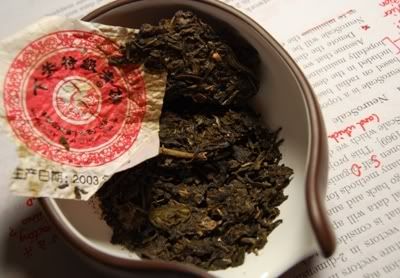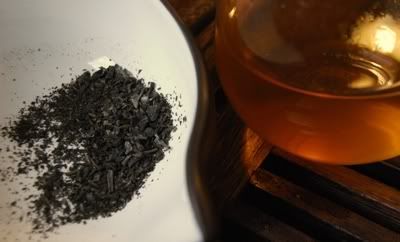An unsung hero: Zidi [purple belly], my principal teapot. I use him to brew shengpu, mostly of a young or middle-aged variety. At around 12cl, he's large enough for a good session. (When faced with older teas, I edge down to a smaller 8cl pot, so that I can use a smaller amount of leaves.) Zidu is my fat little friend, and he makes a very decent brew these days.
Into Zidu's ever-hungry belly today goes some 2003 Xiaguan. I feel like I've been drinking rather a lot from this producer recently, but perhaps that's just because I rather like their approach. I don't have much non-modern Xiaguan, excepting a few mature examples, and this 2003 cake is a nice change of pace.
"Teji" means "first grade". Perversely enough, there are usually lots of grades above "first", for most factories, usually combinations of the phrases "imperial", "tribute", "golden", "reserve", etc., etc.
"Teji" means "first grade". Perversely enough, there are usually lots of grades above "first", for most factories, usually combinations of the phrases "imperial", "tribute", "golden", "reserve", etc., etc.
This is old-school Xiaguan: small fragments of small leaves, with a simple and gentle aroma of sweetness. It's a dark-looking sample (shown above), obtained from Yunnan Sourcing.
There's always lots of leftover leaf material from a Xiaguan (pictured below), and it's good to separate out the fannings, unless you're deliberately trying to increase the punchiness in the initial infusions - and with the fragmented nature of traditional Xiaguan, that's probably not a wise idea.
There's always lots of leftover leaf material from a Xiaguan (pictured below), and it's good to separate out the fannings, unless you're deliberately trying to increase the punchiness in the initial infusions - and with the fragmented nature of traditional Xiaguan, that's probably not a wise idea.
As you can see from the above, this is a soup of deepest orange, and it's very cloudy. However, the aroma is redeeming! It has complex bean-like notes, low and savoury. When sipped, the flavour is instantly everywhere in the mouth: an all-pervasive, tart expression of that bean-like character, but now with not-so-subtle hints of "red" oxidation. Five years old it may be, but these are the notes of hongcha. (It rather reminds me of Nilgiri, in fact.)

I don't lament that this tea is no longer for sale, though it is not unpleasant. Perhaps a touch muted in actual character, as "red" teas invariably become, I wonder if such oxidation is becoming a little too common.
Correspondingly, for a chopped tea, its bitterness is highly restrained: this is often the first thing to go when the producer opts for a little hongcha-like addition to the flavour.
Addio, Teji Bing - I suspect you will not be missed. At least Zidu enjoyed an extra coat or two on his outer skin...
Correspondingly, for a chopped tea, its bitterness is highly restrained: this is often the first thing to go when the producer opts for a little hongcha-like addition to the flavour.
Addio, Teji Bing - I suspect you will not be missed. At least Zidu enjoyed an extra coat or two on his outer skin...
Addendum
In what appears to be an increasingly-common phenomenon, I failed to notice that I already have written about this tea (here)! Amusingly enough in that article, I likened the hongcha-like notes to Assam or Nilgiri. "Not one for my collection", I wrote, and I'll stick by that.




No comments:
Post a Comment